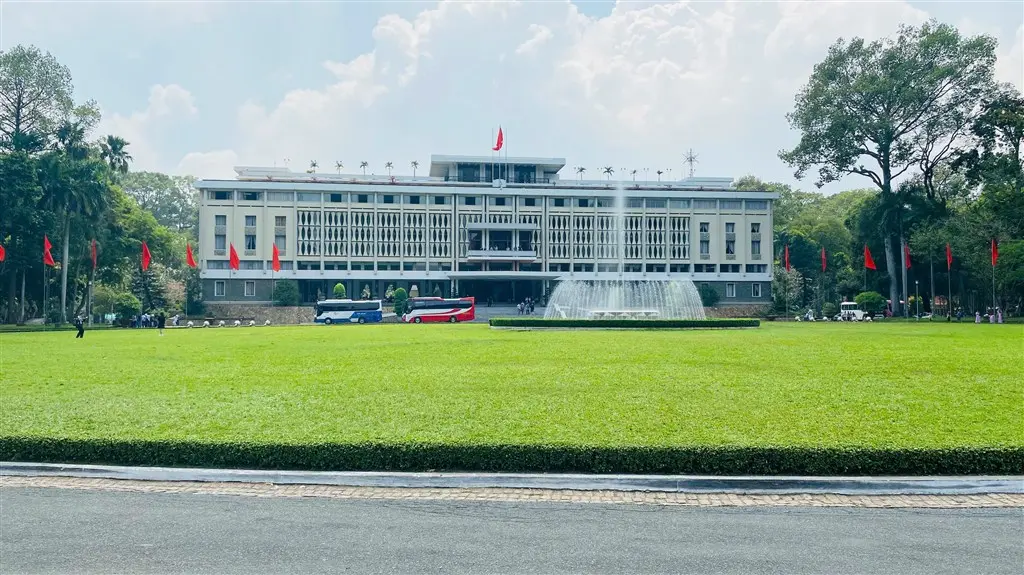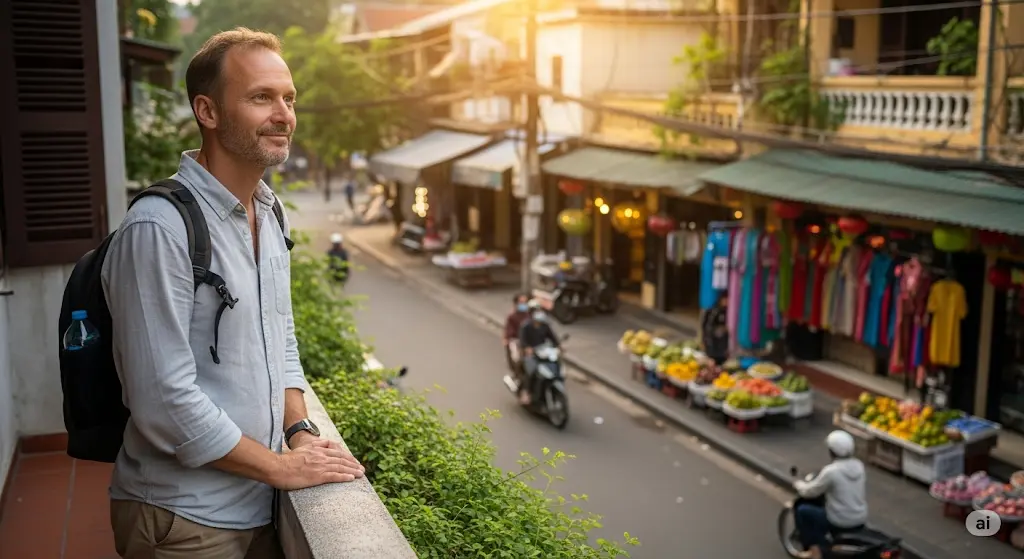Vietnam pulses with energy. Much of this life spills onto the streets. Here, amidst the scooters and chatter, a vibrant culinary scene unfolds. This is the world of Vietnamese street food. It is more than just eating. It is an experience. It connects you to the local culture, the history, and the incredible flavors of the country. EssentialVietNamtravel.com is here to guide you through this delicious landscape.
This guide provides practical steps. We aim for clarity. Anyone reading this should feel confident exploring the food street Vietnam offers. We cover the iconic dishes. We show you where to find authentic vendors. We explain the unique taste profile. We offer crucial safety tips. We suggest ways to enhance your culinary travel. Prepare to eat in Vietnam like a local.
Must-Try Vietnamese Street Food: Iconic Dishes like Pho, Banh Mi, and Bun Cha

Vietnamese street food presents a dazzling array. Certain dishes stand out. They are icons of the cuisine. They represent the heart of Vietnamese eating. Understanding these key dishes is the first step to appreciating the depth of food of Vietnam. They offer a gateway to the complex flavors and textures that define this food culture. Trying these is essential for any visitor wondering what food to have for a visitor from vietnam.
Ready to Taste These Iconic Dishes?
Find the best flight deals to Vietnam and start your street food adventure!
Pho
Pho is arguably the most famous Vietnamese dish. It is a noodle soup. The base is a slow-simmered broth, often beef (Pho Bo) or chicken (Pho Ga). The broth is clear yet deeply flavorful. It holds secrets of star anise, cinnamon, and other spices. Rice noodles swim in this broth. Thin slices of meat join them. A crucial part of the pho experience is the garnish. Fresh herbs like basil, mint, and cilantro are served alongside.
Bean sprouts, lime wedges, and chili slices allow customization. Each Pho bowl becomes a personal creation. You will find pho stalls everywhere, especially in Hanoi, its birthplace. It is a common breakfast, but delicious any time. The dish implies component – the perfect balance of broth, noodle, meat, and herb is key.
Banh Mi
Banh Mi showcases the French influence on Vietnamese cuisine. It is a baguette sandwich. The bread is lighter and crispier than a traditional French baguette. Inside, a symphony of ingredients awaits. Common fillings include grilled pork (Banh Mi Thit Nuong), pâté, cold cuts, and pickled vegetables like carrots and daikon radish. Cilantro sprigs add freshness.
A smear of mayonnaise or chili sauce often completes it. Banh mi is incredibly versatile. You can find vegetarian versions. It is affordable, quick, and satisfying. Look for vendors with fresh bread and generous fillings. Cheap banh mi Ho Chi Minh City is a popular search, highlighting its availability and value.
Bun Cha
Bun Cha is another Hanoi specialty that gained global fame. President Obama famously enjoyed it with Anthony Bourdain, leading to the nickname Bun Cha Obama for some specific spots. This dish features grilled pork patties and slices of pork belly.
They swim in a bowl of diluted fish sauce, slightly sweet and tangy. Alongside comes a plate of fresh rice vermicelli noodles (bun) and a basket overflowing with fresh herbs and lettuce. To eat Bun Cha, you dip the noodles and herbs into the sauce with the pork. The combination of smoky grilled meat, savory sauce, fresh noodles, and herbaceous greens is addictive. The cooking method, often a charcoal grill set up curbside, adds to the authentic street food experience.
Other Notable Dishes
Beyond these giants, explore other delights. Goi Cuon, fresh spring rolls, are a lighter option. Rice paper (Banh Trang) wraps around shrimp, pork, vermicelli noodles, and herbs. Dip them in a peanut sauce. Banh Xeo is a crispy Vietnamese crepe or pancake. It is often filled with pork, shrimp, and bean sprouts. You wrap pieces of the Banh Xeo in lettuce leaves and herbs before dipping.
These Vietnamese snacks showcase the variety available from food stalls. Each dish offers a unique taste and texture, contributing to the rich tapestry of street food vietnamese style. Remember, the Dish implies technique – the crispiness of Banh Xeo or the freshness of Goi Cuon depends on skilled preparation..
Finding Authentic Vietnamese Food Stalls: From Hanoi Streets to Ho Chi Minh City Vendors
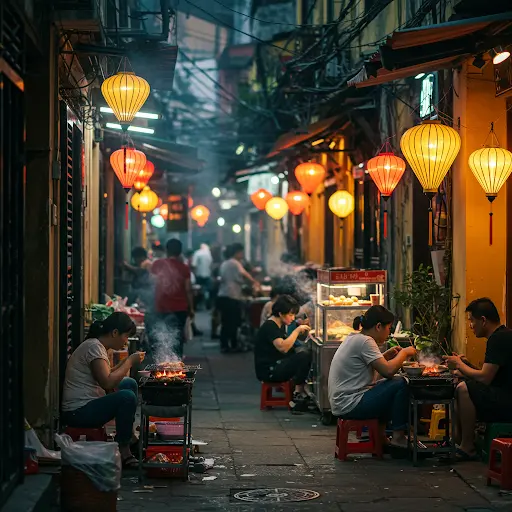
Discovering the best Vietnamese street food requires knowing where to look. Authentic flavor often hides in plain sight, down alleys or on busy street corners. Forget fine dining expectations; embrace the vibrant chaos of the vietnam street. The most memorable meals often come from humble food stalls, served by dedicated vendors, sometimes from the back of a motorbike. EssentialVietNamtravel.com helps you navigate this scene.
Key Locations
Hanoi’s Old Quarter is a prime location. Its narrow streets teem with life and food. Explore the lanes branching off the main roads. Look for clusters of locals gathered around small tables, perched on the ubiquitous plastic stools. This is often a sign of good quality and value.
In the Hanoi Old Quarter, specific streets might specialize in certain dishes. Ask your hotel or guesthouse for hyperlocal recommendations. Finding the best pho street food Hanoi requires a bit of exploration, but the reward is immense. The vendor setting is often the sidewalk itself, creating a communal dining atmosphere.
Ho Chi Minh City (Saigon) offers a different but equally thrilling experience. Ben Thanh Market is a well-known landmark, with a dedicated food court section offering various street food staples. However, venturing beyond the market into surrounding districts like District 1, District 3, or District 4 reveals countless local gems. Look for vietnam street food ho chi minh signs or simply follow your nose.
Motorbike vendors are common here, offering quick snacks or drinks. Their mobility means they might not be in the same spot every day, adding an element of discovery. Vendor implies affordability is a general rule, making street exploration part of budget travel.
How to Identify Authentic Vendors
How do you identify an authentic, high-quality vendor?
- Look for Crowds: Especially local crowds. If a stall is consistently busy, it suggests the food is good and trusted. Popular dishes anticipated here often draw regulars.
- Observe Freshness: Can you see the ingredients? Are they fresh? Are vegetables crisp? Is meat being cooked to order? Freshness is a key characteristic of good Vietnamese cuisine.
- Check for Specialization: Many of the best stalls focus on just one or two dishes. This specialization often leads to mastery of that specific dish. A vendor making only Pho Bo likely makes excellent Pho Bo.
- Watch the Vendor: Are they working efficiently? Does their setup look reasonably organized, even if basic? Experience often shows in their movements.
- Trust Your Senses: Does the food smell appealing? Does the environment feel right? Sometimes intuition is a good guide.
Finding great street food in Vietnam is an adventure. It requires walking, observing, and being open to trying new things. Don’t be afraid to point at what looks good. A smile goes a long way. Exploring the vietnamese food market or a simple vietnamese street market offers insights into daily life and local tastes. This is where you truly eat vietnam style. Remember the assumption: Urban availability presupposed means options are plentiful, especially in major cities.
The Delicious and Unique Flavor Profile of Vietnamese Street Cuisine
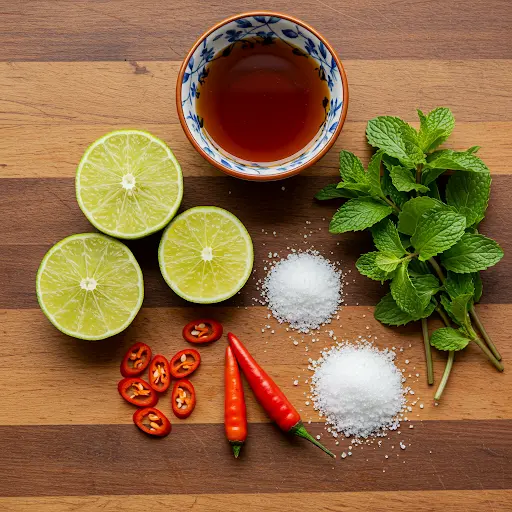
What makes Vietnamese street food so universally loved? It boils down to a unique approach to flavor and ingredients. It is a cuisine that balances freshness, complexity, and vibrancy in a way few others do. Understanding this profile helps you appreciate each bite. This is distinct from formal dining or packaged food. It’s about immediate, impactful taste derived from core principles of Vietnamese cuisine.
Core Principles of Flavor
The cornerstone is the Five flavor balance. Vietnamese cooks strive to incorporate sweet, sour, salty, bitter, and umami (savory depth) into their dishes. This balance creates a harmonious and satisfying taste experience. Fish sauce (nuoc mam) provides saltiness and umami. Lime juice brings sourness. Sugar adds sweetness. Herbs and certain vegetables can introduce a pleasant bitterness. This balance is evident in dipping sauces, broths, and marinades. The resulting Taste Profile is Balanced, rarely letting one flavor dominate excessively.
Fresh herb usage is fundamental. Walk through any Vietnamese food market, and you’ll be struck by the variety and abundance of fresh greens. Mint, cilantro (coriander), various types of basil, sawtooth herb, perilla leaves, and rice paddy herb are just a few examples. These are not mere garnishes; they are integral components, adding layers of aroma, flavor, and texture.
Many street food dishes come with a large platter of fresh herbs, allowing diners to customize their meal. This herbaceous quality contributes significantly to the perceived lightness of the food. Cuisine implies ingredients, and in Vietnam, fresh herbs are paramount.
The French influence adds another layer. While Vietnam has a rich culinary history predating colonization, French ingredients and techniques were integrated selectively. The baguette used for Banh Mi is the most obvious example. Pâté, certain types of cold cuts, and the coffee culture (especially Ca Phe Sua Da) also have French origins. This Influence, Origin, French connection adds specific dimensions to certain street foods.
Regional diversity is significant. Food in the north (like Hanoi) tends to be more subtle, with a focus on savory flavors and black pepper. Central Vietnam (like Hue and Da Nang) is known for spicier, more complex dishes. Southern Vietnam (like Ho Chi Minh City) often features sweeter flavors and more extensive use of coconut milk. Exploring street food in different regions reveals these fascinating variations. Bun Bo Hue, a spicy beef noodle soup, is a prime example of a Region, Specialty dish.
Finally, a characteristic often noted is Lightness. Despite the complex flavors, many Vietnamese street food dishes feel relatively light and healthy compared to other Asian cuisines. This is partly due to the emphasis on fresh vegetables and herbs, restrained use of oil in many dishes, and brothy soups. It makes exploring the food street vietnam a less heavy experience than one might expect.
Understanding what does vietnam eat involves appreciating this balance and freshness. The food of vietnam is designed to be enjoyed frequently, often multiple times a day. Comida vietnam or vietnam comidas reflect this international appreciation for its unique profile.
Eating Safely: Tips for Enjoying Delicious Vietnamese Street Food Worry-Free
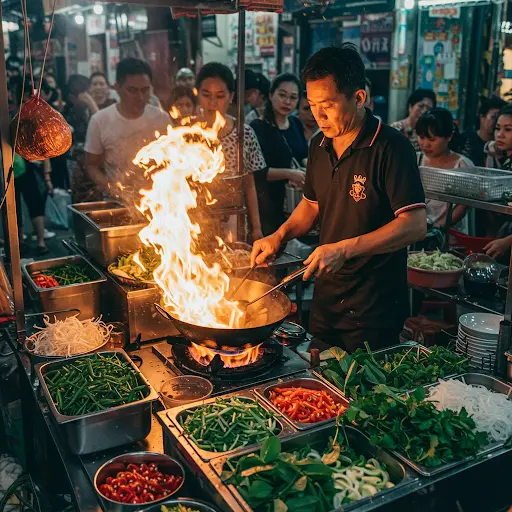
Concerns about hygiene are natural when exploring street food anywhere in the world. Vietnamese street food is generally safe, enjoyed by millions daily. However, taking sensible precautions ensures your culinary adventure remains pleasant. This is important because food safety falls under YMYL (Your Money or Your Life) considerations – getting sick can ruin a trip. EssentialVietNamtravel.com provides this safe vietnamese street food guide based on experience and common sense.
The street food environment is different from a restaurant kitchen. Resources are limited. Preparation happens in open air. Hygiene standards can vary significantly from one vendor to another. The key is to be observant and make informed choices. Hygiene is a consideration you should actively manage.
Practical Safety Steps
Here are practical steps to minimize risks:
- Choose Busy Stalls: Always choose vendors with high customer turnover. This is the golden rule. A busy stall means ingredients are likely fresh because they are used quickly. It also suggests locals trust the vendor.
- Opt for Freshly Cooked Food: Opt for food cooked fresh in front of you. Dishes like pho (boiling broth), banh xeo (fried fresh), or grilled items (bun cha) are generally safer bets than food that has been sitting out for a while. The heat kills most bacteria.
- Observe the Preparation Area: Look at the vendor’s setup. Does it appear reasonably clean given the circumstances? Are raw and cooked ingredients kept separate? Are utensils rinsed or wiped? Absolute sterility isn’t expected, but look for general cleanliness.
- Watch Food Handling: Does the vendor use gloves or tongs to handle ready-to-eat food? Or do they use bare hands? While bare hands are common, observe if they handle money and food without washing in between. This increases risk.
- Be Cautious with Ice and Water: Ice is generally safe in established restaurants and cafes in tourist areas. On the street, it can be variable. If you have a sensitive stomach, consider avoiding drinks with ice from street vendors or asking for no ice (‘khong da’). Stick to bottled or canned drinks if unsure. Tap water is not potable; always drink bottled water.
- Wash Your Hands: Carry hand sanitizer or wet wipes. Use them before eating, especially since you might be using your hands (e.g., wrapping banh xeo).
- Peel Fruit Yourself: If buying fresh fruit from a street vendor, choose fruits you can peel yourself, like bananas or mangoes. Avoid pre-cut fruit that may have been sitting out.
- Listen to Your Body: Start slowly. Don’t overwhelm your system with too many new foods on the first day. If something tastes off, don’t feel obligated to finish it.
Street Food, Safety, Variable – these three terms summarize the situation. By being mindful and following these tips, you significantly reduce any risks. Millions enjoy delicious street food in vietnam daily without issue. Authenticity assumed should not mean safety ignored. Assess food safety actively for a positive experience.
How to Experience the Best Vietnamese Street Food: Tours and Local Insights
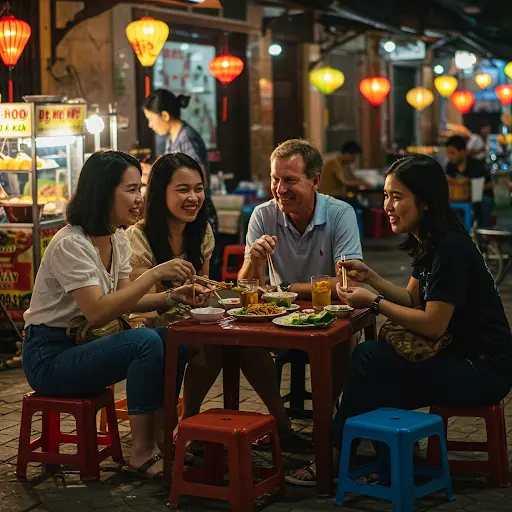
Simply eating Vietnamese street food is one thing; truly experiencing it involves understanding the context, culture, and nuances. There are ways to deepen your appreciation and ensure you find the hidden gems beyond the obvious choices. Whether you explore independently or join a tour, a little insight goes a long long way in your food trip vietnam. EssentialVietNamtravel.com encourages embracing the full experience.
Guided Street Food Tours
A Street food tour can be an excellent introduction, especially if you are short on time or hesitant to explore alone. Reputable tours are led by knowledgeable local guides. They navigate the bustling streets, taking you to pre-vetted, high-quality vendors known for specific dishes. This addresses the “Find food tours” search intent directly. Benefits include:
- Efficiency: Sample a variety of dishes in a few hours.
- Local Knowledge: Guides share insights into culinary history, ingredients, and eating etiquette. They know the hyperlocal spots.
- Safety: Good tour operators prioritize hygiene and choose reliable vendors.
- Navigation: No need to worry about getting lost or language barriers.
- Context: Understanding the story behind the food enhances the experience. Look for options like a “Street food tour Da Nang price” if you’re in Central Vietnam. An organized Experience, Type, Food Tour can be invaluable.
Independent Exploration Tips
Exploring independently also offers immense rewards. It allows for spontaneity and personal discovery. Here’s how to make the most of it:
- Observe Locals: See where they eat. Notice how they eat certain dishes (e.g., assembling their own rolls, adding specific condiments). Don’t hesitate to politely mimic them.
- Be Adventurous (Within Reason): Step outside your comfort zone and try something unfamiliar. Look for dishes you haven’t seen before. However, balance this with the safety tips mentioned earlier.
- Learn Basic Phrases: Knowing how to say “hello” (xin chào), “thank you” (cảm ơn), “delicious” (ngon quá), and numbers for payment can enrich interactions.
- Embrace the Setting: Part of the charm is sitting on tiny plastic stools by the roadside. It fosters a Communal atmosphere. Share a table if needed. Enjoy the street theatre unfolding around you. This is authentic vietnamese street life.
- Understand Unwritten Recipes: Many street food vendors rely on Generational knowledge and Unwritten recipes passed down through families. This contributes to the unique, often inimitable taste of their offerings. Activity implies outcome – the outcome here is delicious, time-tested food.
Engaging with Vietnamese street food is a key part of Southeast Asian travel. It connects you directly to the Vietnamese culture. It’s not just about sustenance; it’s about community, tradition, and the simple joy of incredibly Flavorful, Affordable food. The assumptions are generally correct: Authenticity assumed (it often is), Low cost expected (it usually is), making it ideal for Budget travel and Food tourism.
Beyond the Plate: Essential Vietnamese Street Drinks to Complement Your Food
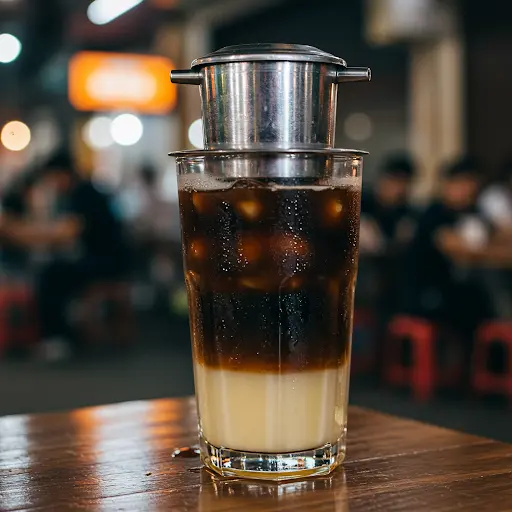
Your Vietnamese street food adventure isn’t complete without exploring the drinks often served alongside. Just like the food, street drinks in Vietnam are flavorful, refreshing, and an integral part of the culinary landscape. They complement the meals, cleanse the palate, or offer a welcome pause during your explorations. EssentialVietNamtravel.com highlights a few key beverages to seek out.
Must-Try Street Drinks
The undisputed king of Vietnamese street drinks is Ca Phe Sua Da. This translates to iced coffee with condensed milk. Strong, dark-roast coffee is brewed using a small metal filter called a ‘phin’, dripping slowly into a glass containing a generous layer of sweet condensed milk. Once brewed, the coffee is stirred vigorously with the milk and poured over a full glass of ice.
The result is a potent, sweet, and intensely flavorful coffee that provides a perfect caffeine kick. It’s a cultural institution, enjoyed morning, noon, and night at cafes and street stalls alike. Finding a good spot for Drink, Type, Ca Phe Sua Da is a quintessential Vietnam experience.
Beyond coffee, fresh sugarcane juice (nuoc mia) is incredibly popular, especially on hot days. Vendors feed stalks of sugarcane through mechanical presses, extracting the sweet, grassy juice. Often, a small calamansi lime or kumquat is added for a touch of tartness. It’s incredibly refreshing and hydrating. Look for vendors with active presses and fresh-looking sugarcane.
Various fresh fruit juices and smoothies (sinh to) are also widely available. Depending on the season, you can find blends of mango, avocado, dragon fruit, passion fruit, and more, often mixed with condensed milk or yogurt for creaminess.
Herbal teas (tra da) are often served free with meals at many street food stalls and basic eateries. This complimentary iced tea, usually jasmine or green tea, is light and refreshing, acting as a good palate cleanser between bites of flavorful food.
For those seeking something stronger, local beers (bia hoi – fresh, light draft beer, or bottled brands like Saigon Beer, 333, Huda) are commonly enjoyed with street food, especially in the evenings. Sharing beers and snacks with friends is a popular social activity.
Trying these drinks enhances your overall street food experience. They offer different flavors and serve different purposes, from providing energy to cooling you down. Don’t hesitate to point and try what looks interesting at drink stalls. They are an affordable and delicious part of the Vietnam eat culture.
Vietnamese street food is more than just a meal; it is a vibrant cultural immersion. From the steaming Pho bowl in Hanoi to the crispy Banh Mi in Ho Chi Minh City, the flavors are diverse, Delicious, and deeply satisfying. Finding these treasures involves exploring bustling streets, seeking out dedicated Food stalls, and trusting the crowds gathered on Plastic stools. Understanding the Five flavor balance, the importance of Fresh Herbs, and the subtle French influence unlocks a deeper appreciation for the Vietnamese cuisine.
While Hygiene requires mindful attention, following simple safety guidelines allows you to enjoy this Authentic food with confidence. Enhance your journey with a Street food tour or by observing locals and embracing the Communal spirit. Complement your meals with iconic drinks like Ca Phe Sua Da.
EssentialVietNamtravel.com hopes this guide empowers you to dive into the incredible world of vietnamese street food. It’s Affordable, accessible, and offers some of the most memorable tastes you’ll encounter during your Culinary travel in Vietnam. Go explore, be adventurous, and savor every bite. The streets await.

